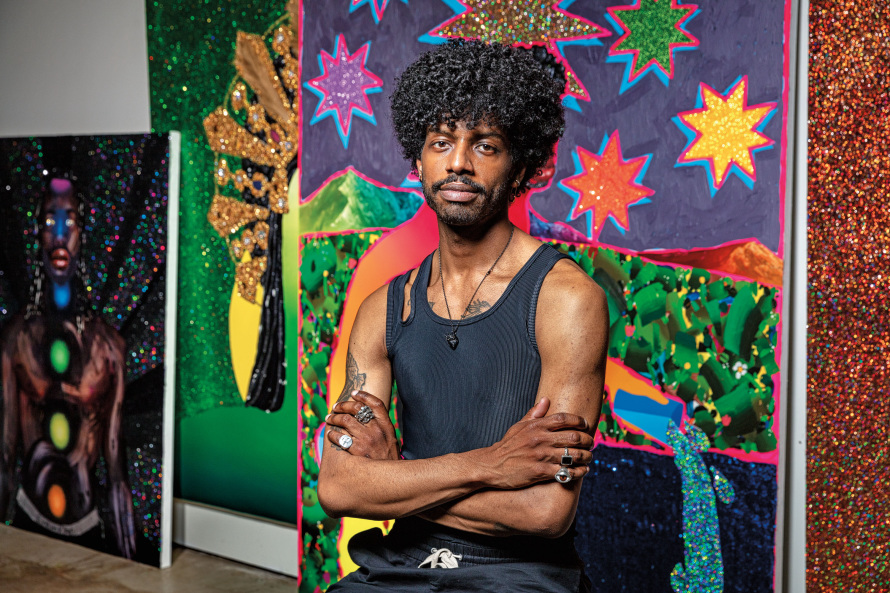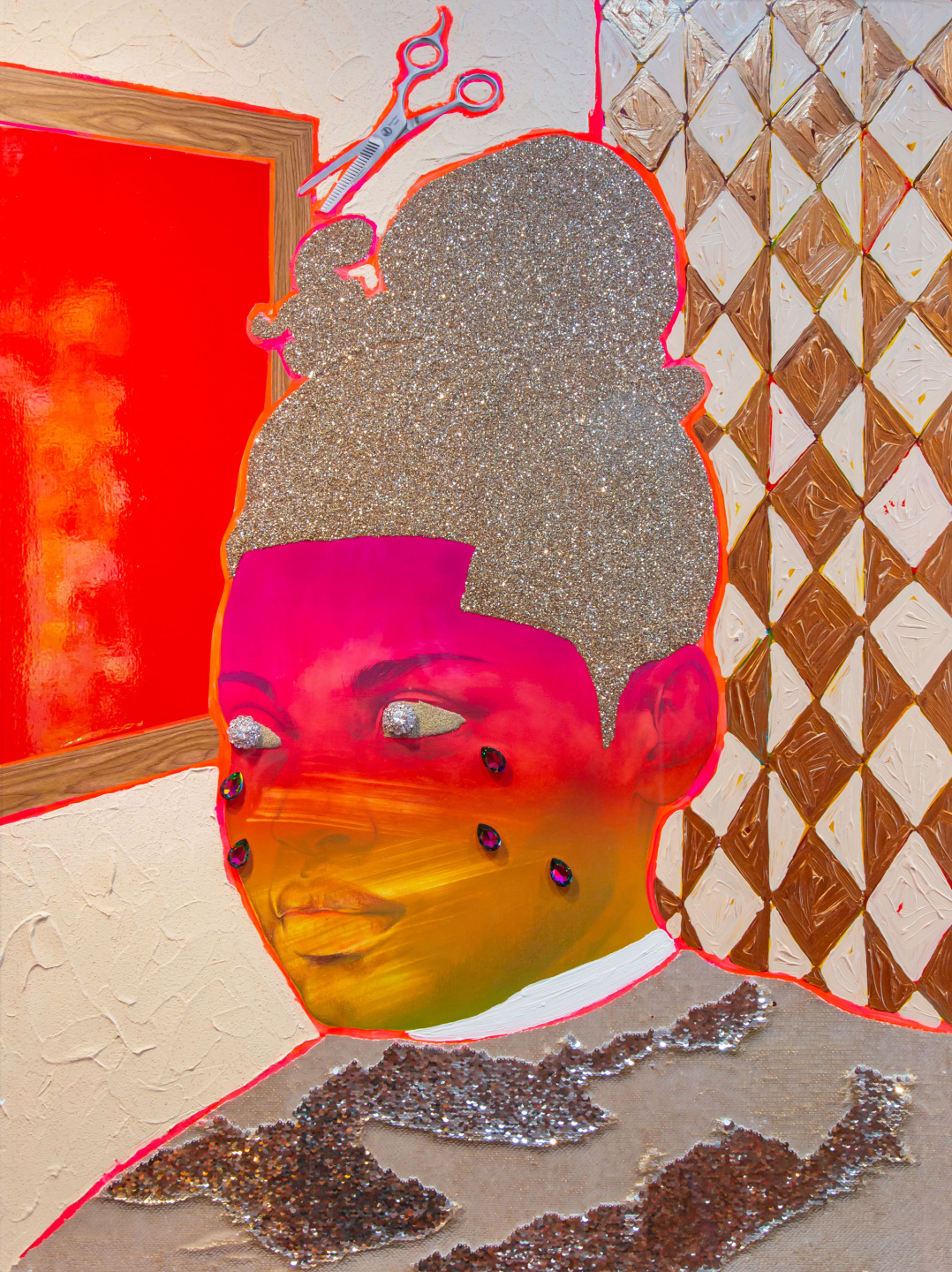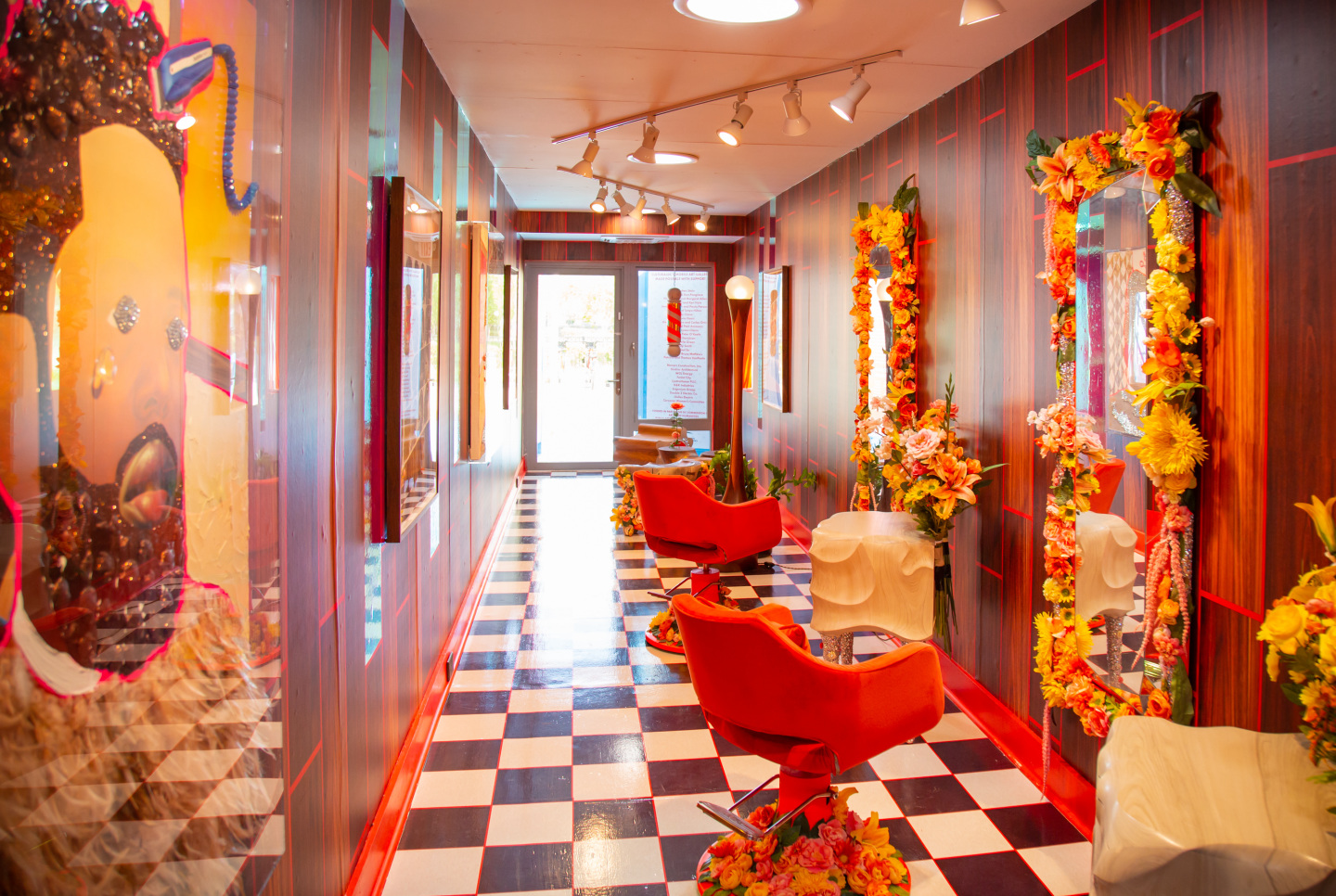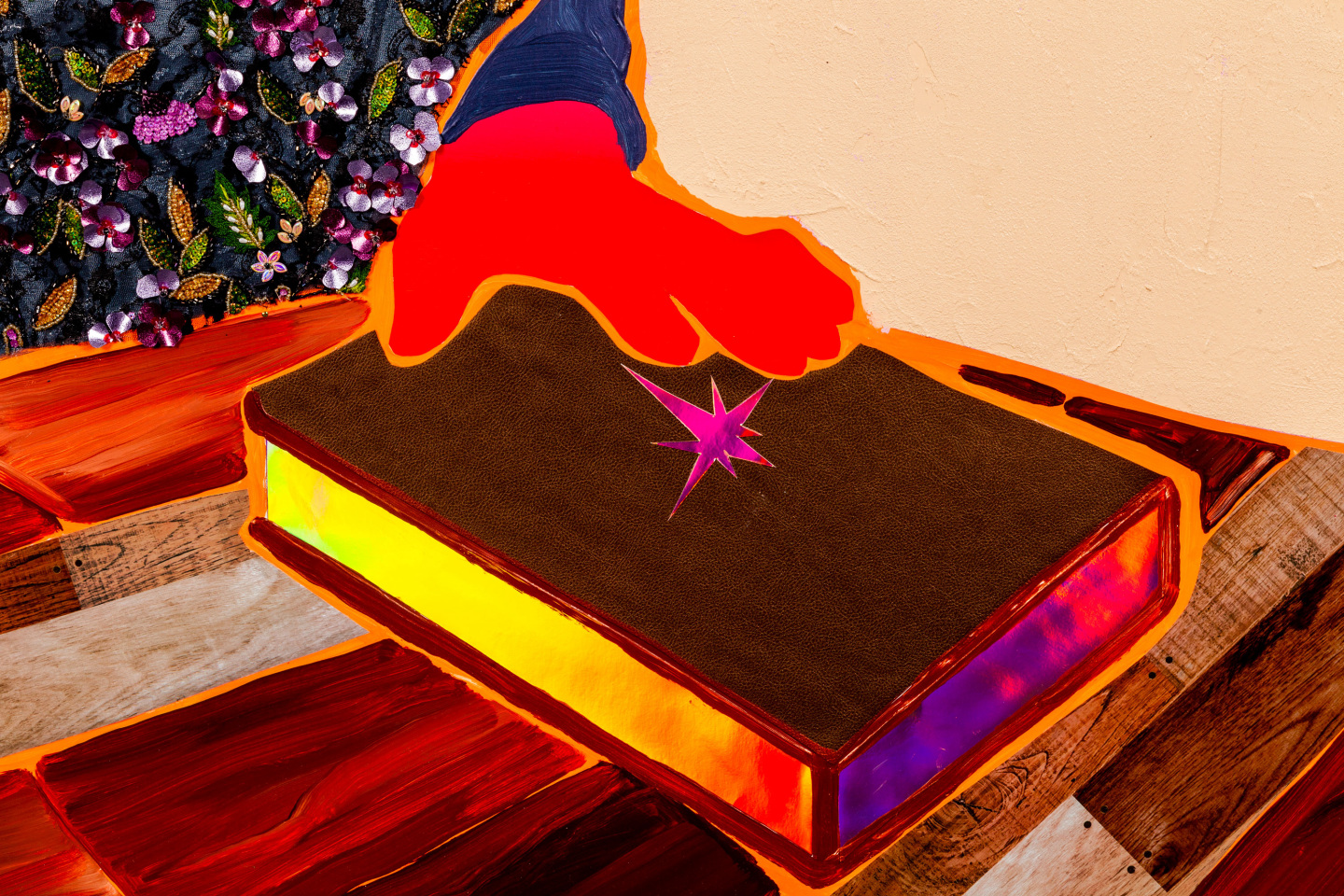In a previous life, Lauren Mayberry was a journalist, which often involves a driving need to talk to people you admire, and in this life and in all prior lives, she is and was a fan. She loves a number of artists in all disciplines, and is never afraid to signal-boost them and direct her followers to their work. That generosity brings visibility and builds community. Her Instagram has become an homage to a number of artists: Barbara Kruger, David Lynch, Nam June Paik. When I asked her if she might like to interview a visual artist, Devan Shimoyama was top of our minds, because he too, as evinced by this interview, is a fan of a variety of creatives in a variety of media. His work is both a celebration and an inquiry. It tells a different kind of history, a different kind of truth about the world we are already in. And above all it does not shy away from beauty or a love of beauty. Devan and Lauren, it seems to me, constantly work through what it means to love, which is a form of fandom, and from love emerges every question we could ever ask.
Lauren Mayberry: Thank you so much for making time to chat. You’re in Pittsburgh for lockdown?
Devan Shimoyama: Yeah. I’ve been here for seven years. I came right after grad school.
LM: Have you been able to work much during these last six months?
DS: When the pandemic really hit, at least in terms of when quarantine started cracking down in March, I immediately lost access to my studio that I had previously. I’ve made some work at home. I started making some drawings, about four of them. They are a pretty big undertaking, for me at least, just because my drawings tend to be pretty large in scale, so I’ve been making those at home with just colored pencil, and it has been really tedious. So, it ate up a lot of my time which has been really nice, but production in the studio has totally halted otherwise.
LM: I’ve been talking to a lot of friends about music venues and what’s been happening there. I imagine it’s pretty similar for galleries, in terms of being shut down…
DS: Yeah, you know what’s funny: I was just talking to a student, one of the grad students at Carnegie Mellon, where I teach, and she is doing a lot of experimental music. Nightlife is totally just not a thing. So, she’s having to do these really tiny gatherings, with maybe like five people in a really huge room to do a performance. And, you know with galleries, a lot of it has moved online in some capacity but, they’ve been opening back up to limited numbers of people in actual physical spaces for some things. So, most of the stuff that I’ve shown since quarantine has started has been in person. I’ve only done maybe one or two things online and usually everything has an online version of the thing in real space, at least. But the art fairs are all online.

LM: Interesting. I did wonder, because I follow you on Instagram, what is your relationship to the online aspect of promoting art? For the time and the emotion and the energy you put into work, to then have it be like a little square on the internet must be very strange.
DS: Yeah. It is, but things have been going in that direction to some extent since Instagram came out. That’s how most people experience my work, just through social media, unless they get a chance to see it in person, if they are in a major city or wherever my work happens to be. Most people following me probably haven’t even seen it in person and it’s such a strange thing to think about. Actually, just last month in September, I did this project with Lovecraft Country on HBO. They had this VR experience that incorporated three artists’ work in the space. You go through this really crazy thing called Sanctum, and it’s this guided tour in a virtual-reality alternate dimension. You get to experience the work on this grand scale and animated through VR. That was a unique thing that I hadn’t considered, experiencing work in a kind of virtual space.
LM: It is really interesting that you say that because I guess I’ve been trying to find the positives of the absolute bottom falling out of both of our industries and I’m like, well, maybe it will push people to think about how they can actually help people who don’t have the means or aren’t geographically in the places where they can access things. How they can open things up through technology in a way that’s… positive? Maybe that will be helpful?
DS: Yeah, and I’m noticing a lot of different platforms coming out that are online where people are reimagining how work can exist in a way that’s accessible to people more broadly. I think that people are starting to think about how technology can be used in this way, but at the end of the day, something’s still lost without actually experiencing something in real time. You know, experiencing music live and being there with that type of energy is so vastly different than just listening to it on your own or going into another type of space with a limited number of people in it. It just changes everything.
LM: What I love whenever I am looking at your work is how you take ideas of masculinity or sexuality or race or class and put those things in such an interesting context. Are those things that you’re consciously drawn to when you’re creating?
DS: Yeah! It’s interesting. I have two studios. In my other studio I’m currently working on these two paintings that are just for me. I’m making this work, thinking about myself when I was like 12 or 13 or something. I’ve created this fictional R&B girl group, pop girl group.
LM: I saw your [fake cover art] and I was like I want this band to be real! I need this! [Laughing]
DS: I have three of them that are made now and two of them are going to be shown pretty soon in a group show. Their name is Diamond and there’s originally four girls in the group. I have a whole narrative, now there’s only three.
LM: Well, it happens.
DS: [Laughs] There’s always one. That work for me is very much thinking about the past, looking at music, looking at who I’ve idolized and loved and adored and my affinity for women in music and it’s like just such a fun project to work on. I’m looking at mythology or I’m looking at just people in my life or in my day-to-day and I’m just so fortunate to make work in so many different ways and think through so many different types of ideas and have people still be excited to look at it and to think about it. I’m thinking about, largely, femme or female-presenting people that are of significance in my life or that I’ve sort of idolized or looked to. And that’s in all of my work, not just that music work. When I was growing up, I grew up in a Baptist Christian church and there were women with big hats and the feathers and big custom jewelry. I also look to drag queens. I’ve become close to a lot of performers. They are sort of mirroring or mimicking femininity from powerful female musicians or idols. But yeah, I think a lot about how the material choices that I’m making are so influenced by my own affinity for women and how they’ve been the people who have kept me safe when I was growing up in school or made me feel at home or welcomed and loved and cared for and make some of the smartest, most effective leaders. I think that a lot of my choices are reflective of that.



LM: Do you kind of visualize what it is you are going to create before you begin, or do you figure it out as you’re going?
DS: I’m pretty good at responding to dreams. I also collect images a lot. I take screenshots all the time or I’ll take photos on the go and I’ll just have an archive of a ton of different things. Sometimes, something will really click where I’ll see the entire image and I’ll have to make the painting. That’s a moment of urgency that happens, where something falls into place and I can see it in my mind. I’ll often sketch it really quickly, either on my phone or something with like a cheap little app that I can paint with on my phone. Or I’ll write down exactly the vision that I had and I’ll make it. Obviously, things change in the studio because I’m responding to colors and materials and everything else but a lot of times I do see the painting in my head first and then I’ll just jump into it and try to make the thing. It’s funny that you say that, because I always think about music or even poetry. Poetry creates this activated thing that’s different but it really transports me in a different way than painting does, in this really exciting way. It takes me into this other type of space where it’s all sensory and feeling and I love that so much. I think that’s so powerful and amazing. Like I listen to “Clearest Blue” all the time, by the way.
LM: Oh my god you’re probably like, “I gotta get it done quickly!”
DS: It just like really gets me in the zone. I just really love things like that.
LM: I’ve genuinely become more conscious of this as we’ve gotten older, but if I’m ever stuck or like in a block or something, I feel like experiencing art really helps get things moving. I was reading this essay that Nick Cave wrote, and he said that he feels that so much of his time when he’s creating is spent taking in other people’s creativity; ten percent of the time I feel like that’s me topping up my cup and learning things. I feel like I’m spending so much time watching films or looking at art or reading and it gets my motor running!
DS: I listen to music all the time in the studio but I rotate between music and audiobooks, sometimes interviews. Audiobooks get me through a lot of things. I listen to a lot of sci-fi or epic fantasy novels. Those things really help me. They just have a different type of feeling and pacing. It depends on what I am doing, I think, in the studio. What’s nice about music is that I don’t have to always be paying attention so much, whereas with audiobooks, I kind of need to focus. Like right now I’m listening to Song of Solomon by Toni Morrison, but I can’t listen to that all the time in the studio because I really do pay attention to it.
LM: When it’s Toni, you have to focus! That makes the Lovecraft Country connection make a lot of sense too, cause that’s so vivid and visual but so sci-fi, creepy. I watched the first episode and I was like “Oh my god, I did not see that coming at all,” but I love it so much. And the colors, the design of it. When I was a kid, I wanted to be the person who makes the houses that people live in on TV. I don’t know what my child brain was talking about. Now I know I’m just not artistic in that way at all. I’ll just be like “Does this go? Does this look nice?” I don’t know. I feel like the thing I always come back to is different kinds of storytelling. Whenever I look at your work, I’m like, they are such important stories that you’re telling, whether it seems like it’s about you or other people. Are you conscious of trying to tell a story?

DS: Yes and no. I do think a lot about narratives. My introduction into a lot of images paired with texts was from fairy tales when I was growing up. I’m thinking of a panel that accompanies a much more didactic text perhaps, that tells a story. My work alludes to a story or it is born out of a reference from a pre-existing narrative or something that I’ve read. I love Greek mythology. I love Caribbean folklore. I think that there are a lot of inventive stories in the Bible that are really fascinating. They come out of the Fertile Crescent and stem from different territories of religious studies and art that are so incredibly fascinating in terms of why we tell the stories that we tell. I am more so interested in providing an image that might allow the viewer to then take it and run with it and create their own narrative, if that makes sense, for them. I love that.
LM: I’ve noticed that in a lot of pieces, there are people carrying books or reading books. You must take a lot of inspiration from literature and writing and purposely put those in the work as well.
DS: Yeah, I’ve become really close friends with a poet, Rickey Laurentiis, who is just a really incredible thinker. They worked with me for my first museum exhibition, and they wrote an essay in my catalogue for “Cry, Baby” at the Warhol Museum. They also organized some really incredible programming, particularly “The Black Ecstatic,” which was an evening of poetry. The energy was so specific in that and there was a potency to it that was different than just passively reading on your own. I was like, people should be reading more! I really do think the way in which people understand and construct their own identities or understandings of the world come through reading and art and those intersections of the ways in which people reinterpret or reimagine or re-tell stories and explain things through visual or auditory or written ways of working. I want to create this suggested reading in a lot of ways. A lot of things that influence my own ways of thinking or understanding of myself or understanding politics come through unconventional means. I’m not just reading dry theoretical texts. I’m really interested in how poetry, prose, sci-fi, biobehavioral health texts, etc. can really be informative in understanding myself or oneself. That’s where that body of work came out of.
LM: I think that’s so interesting because I was looking at it being like, “Oh, I haven’t read that!” or “Oh, I’ve read that!” and then going through it. That’s like the visual art version of when I would read interviews with Radiohead when I was a teenager and they would talk about Kraftwerk and I would be like “What is a Kraftwerk?” and I would go look it up. I feel like that’s so fun, as someone who is taking in someone else’s creativity to figure out how they got to where they got to and what inspired that person to create this thing which then inspired you. I like that domino effect of things. I appreciate those Easter eggs. Anyway, I feel hopeful or maybe you’re just catching me on an upbeat day, but part of me is like I hope that when the world starts to move at a more regular pace that there’s more gratitude for this kind of stuff. The things I find the most comforting and good for my fucking mental health have been other people’s art, what they are making. It’s essential that humans make art and I feel like most people, hopefully, come to that same conclusion during this time. Maybe when we go back in the world, it will be better?
DS: Hopefully. Yeah, I think so. I was also going to ask you, have you been able to be productive?
LM: In the end, we ended up being productive. We were maybe three weeks into recording and making the new album when all the lockdowns went into place. We were like, “Oh we’ll be home for a few weeks and then we’ll figure it out.” A very fucking naive understanding of what was going to happen. I feel like when it was springtime, I thought, “I got all this time, I’m not on tour, I’ll make five albums!” Then, it just wasn’t… I think just the sheer weight and horror of everything that was happening made it really difficult to actually make anything. It would just come in such waves. After that, we set a schedule and we’ve finished the album. It was so, so weird to make an album basically over Zoom. We were able to come back together for the mixing but we were all recording everything separately and then sending it in. It was nice in a way because I was like, even though I see those guys all the time when we’re touring, it’s never like meeting up every day, consciously, to create something. It’s just getting in a van and going somewhere, to do something. There’s not that same kind of purpose to it. I think it’s made everybody a lot more appreciative of each other and appreciative of the safe haven that creativity is.
DS: That sounds like The Postal Service and when they made that album.
LM: Everybody was like “Woah, what an insane thing they’ve done, they made an album separately by sending it through email.”
DS: Now look, here we are!










 in your life?
in your life?

